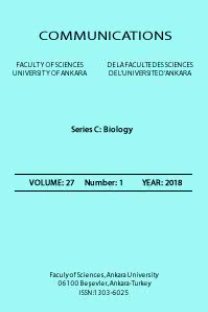An investigation of Pseudomonas marincola to determine Pb(II) biosensor potential
An investigation of Pseudomonas marincola to determine Pb(II) biosensor potential
Pseudomonas marincola biosensor, lead, heavy metal,
___
- Romanenko, L.A., Uchino, M., Tebo, B.M., Tanaka, N., Frolova, G.M., Mikhailov, V.V., Pseudomonas marincola sp. nov., isolated from marine environments. International Journal of Systematic and Evolutionary Microbiology, 58 (3) (2008), 706–710. https://doi.org/10.1099/ijs.0.65406-0.
- Khudur, L.S., Gleeson, D.B., Ryan, M.H., Shahsavari, E., Haleyur, H., Nugegoda, d., Ball, A.S., Implications of co-contamination with aged heavy metals and total petroleum hydrocarbons on natural attenuation and ecotoxicity in Australian soils. Environmental Pollution, 243 (2018), 94-102. https://doi.org/10.1016/j.envpol.2018.08.040.
- Halliwell, B., Gutteridge, J.M.C., The importance of free radicals and catalytic metal ions in human diseases. Molecular Aspects of Medicine, 8(2) (1985), 89-193. https://doi.org/10.1016/0098-2997(85)90001-9.
- Laidlaw, M.A.S., Gordon, C., Ball, A.S., Preliminary assessment of surface soil lead concentrations in Melbourne, Australia. Environmental Geochemistry and Health, 40 (2018), 637–650. https://doi.org/10.1007/s10653-017-0010-y.
- Tsekenis, G., Filippidou, M.K., Chatzipetrou, M., Tsouti, V., Zergioti, I., Chatzandroulis, S., Heavy metal ion detection using a capacitive micromechanical biosensor array for environmental monitoring. Sensors and Actuators B: Chemical, 208 (2015), 628–635. https://doi.org/10.1016/J.SNB.2014.10.093.
- Chakrapani, G., Mahanta, P., Murty, D.S., Gomathy, B., Preconcentration of traces of gold, silver and palladium on activated carbon and its determination in geological samples by flame AAS after wet ashing. Talanta, 53(6) (2001), 1139–1147. https://doi.org/10.1016/S0039-9140(00)00601-9.
- Liang, P., Cao, J., Liu, R., Liu, Y., Determination of trace rare earth elements by inductively coupled plasma optical emission spectrometry after preconcentration with immobilized nanometer titanium dioxide. Microchimica Acta, 159(1) (2007), 35–40. https://doi.org/10.1007/s00604-006-0708-5.
- Pelossof, G., Tel-Vered, R., Willner, I., Amplified Surface Plasmon Resonance and Electrochemical Detection of Pb2+ Ions Using the Pb2+-Dependent DNAzyme and Hemin/G-Quadruplex as a label. Analytical Chemistry, 84(8) (2012), 3703–3709. https://doi.org/10.1021/ac3002269.
- Duffy, E., Morrin, A., Endogenous and microbial volatile organic compounds in cutaneous health and disease. TrAC - Trends in Analytical Chemistry, 111 (2019), 163-172. https://doi.org/10.1016/j.trac.2018.12.012.
- De Guzman, K., Al-Kharusi, G., Levingstone, T., Morrin, A., Robust epidermal tattoo electrode platform for skin physiology monitoring. Analytical Methods, 11 (2019) 1460-1468. https://doi.org/10.1039/c8ay02678e.
- Yüce, M., Nazir, H., Dönmez, G., A voltammetric Rhodotorula mucilaginosa modified microbial biosensor for Cu(II) determination. Bioelectrochemistry, 79(1) (2010), 66-70. https://doi.org/10.1016/j.bioelechem.2009.11.003.
- Yüce, M., Nazir, H., Dönmez, G., An advanced investigation on a new algal sensor determining Pb(II) ions from aqueous media. Biosensors and Bioelectronics, 22(2) (2010), 321-326. https://doi.org/10.1016/j.bios.2010.08.022.
- Woolever, C.A., Dewald, H.D., Differential pulse anodic stripping voltammetry of barium and lead in gunshot residues. Forensic Science International, 117 (2001), 185-190. https://doi.org/10.1016/S0379-0738(00)00402-3.
- Akyilmaz, E., Dinçkaya, E., An amperometric microbial biosensor development based on Candida tropicalis yeast cells for sensitive determination of ethanol. Biosensors and Bioelectronics, 20(7) (2005), 1263–1269. https://doi.org/10.1016/j.bios.2004.04.010. Akyilmaz, E., Yaşa, I., Dinçkaya, E., Whole cell immobilized amperometric biosensor based on Saccharomyces cerevisiae for selective determination of vitamin B1 (thiamine). Analytical Biochemistry, 354 (1) (2006), 78–84. https://doi.org/10.1016/j.ab.2006.04.019.
- Puy-Llovera, J., Pérez-Ràfols, C., Serrano, N., Díaz-Cruz, J.M., Ariño, C., Esteban, M., Selenocystine modified screen-printed electrode as an alternative sensor for the voltammetric determination of metal ions. Talanta, 175 (2017), 501-506. https://doi.org/10.1016/j.talanta.2017.07.089.
- Aragay, G., Merkoçi, A., Nanomaterials application in electrochemical detection of heavy metals. Electrochimica Acta, 84 (2012), 49-61. https://doi.org/10.1016/j.electacta.2012.04.044.
- Pérez-Ràfols, C., Serrano, N., Díaz-Cruz, J.M., Ariño, C., Esteban, M., Penicillamine-modified sensor for the voltammetric determination of Cd(II) and Pb(II) ions in natural samples. Talanta, 114 (2015), 569-573. https://doi.org/10.1016/j.talanta.2015.06.083.
- Pérez-Ràfols, C., Serrano, N., Díaz-Cruz, J.M., Ariño, C., Esteban, M., A chemically-bound glutathione sensor bioinspired by the defense of organisms against heavy metal contamination: Optimization of the immobilization conditions. Chemosensors, 5(2) (2017), 12. https://doi.org/10.3390/chemosensors5020012.
- Serrano, N., González-Calabuig, A., Del Valle, M., Crown ether-modified electrodes for the simultaneous stripping voltammetric determination of Cd(II), Pb(II) and Cu(II). Talanta, 138 (2015), 130-137. https://doi.org/10.1016/j.talanta.2015.01.044.
- Yuan, W., Kuang, J., Yu, M., Huang, Z., Zou, Z., Zhu, L., Facile preparation of MoS2@Kaolin composite by one-step hydrothermal method for efficient removal of Pb(II). Journal of Hazardous Materials, 405 (2020), 124261. https://doi.org/10.1016/j.jhazmat.2020.124261.
- Bilal, M., Iqbal, H.M.N., Microbial-derived biosensors for monitoring environmental contaminants: Recent advances and future outlook. Process Safety and Environmental Protection, 124 (2019), 8-17. https://doi.org/10.1016/j.psep.2019.01.032.
- Van Der Meer, J.R., Tropel, D., Jaspers, M., Illuminating the detection chain of bacterial bioreporters. Environmental Microbiology, 6(10) (2004), 1005-1020. https://doi.org/10.1111/j.1462-2920.2004.00655.x.
- ISSN: 1303-6025
- Yayın Aralığı: Yılda 2 Sayı
- Başlangıç: 1943
- Yayıncı: Ankara Üniversitesi
Esra ENGİN KİLİC, Hatice MUTLU EYİSON, Erkut KİVANC
An investigation of Pseudomonas marincola to determine Pb(II) biosensor potential
Cihan BOSTANCI, Hasan NAZIR, Gönül DÖNMEZ
Copper(II) bioremoval by thermophile Cyanobacterium aponinum
Seda ŞEN, Nur KOÇBERBER KILIÇ, Gönül DÖNMEZ
Kübra KARAKAŞ, Kamil Mert ERYALÇIN, Mehmet Borga ERGÖNÜL, Tahir ATICI, Sibel ATASAGUN
New record of exotic land snail Rumina decollate (Linnaeus, 1758) in Iraq
Ragda H. AL-QAİSİ, Khansaa FARMAN
Fatih DİKMEN, Vahide Cansu SEYMENOĞLU, Mehmet Borga ERGÖNÜL
Kamil CANDAN, Elif YILDIRIM, Yusuf KUMLUTAŞ, Osman Sinan GÜNİSTER, Çetin ILGAZ
